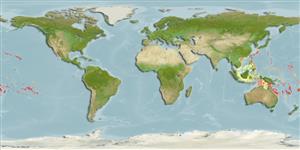>
Ovalentaria/misc (Various families in series Ovalentaria) >
Pomacentridae (Damselfishes) > Chrominae
Etymology: Dascyllus: Greek, daskillys, -on = a kind of fish (Ref. 45335).
Environment: milieu / climate zone / depth range / distribution range
Écologie
marin récifal; non migrateur; profondeur 3 - 40 m (Ref. 7247). Tropical
Pacific: southeastern Oceania including Society Islands, Tuamoto Islands, Pitcairn Group, and Rapa.
Taille / Poids / Âge
Maturity: Lm ? range ? - ? cm
Max length : 12.0 cm TL mâle / non sexé; (Ref. 9710)
Description synthétique
Clés d'identification | Morphologie | Morphométrie
Épines dorsales (Total) : 12; Rayons mous dorsaux (Total) : 15 - 16; Épines anales: 2; Rayons mous anaux: 13 - 14.
Adults inhabit coral and rocky reefs (Ref. 7247). A protogynous hermaphrodite (Ref. 55367). Feeds on zooplanktons (Ref. 89972). Oviparous, distinct pairing during breeding (Ref. 205). Eggs are demersal and adhere to the substrate (Ref. 205). Males guard and aerate the eggs (Ref. 205). Diurnal species (Ref. 54980; 113699).
Life cycle and mating behavior
Maturities | Reproduction | Spawnings | Egg(s) | Fecundities | Larves
Forms permanent harem groups composed of a single male and several smaller females (Ref. 55367). A monandric species (Ref. 55367). Oviparous (Ref. 205). Eggs are demersal and adhere to the substrate (Ref. 205). Males guard and aerate the eggs (Ref. 205). While protogyny was originally proposed for this species such as the report of length at sex change = 6.8 cm TL (Ref. 55367), recent studies confirmed gonochorism in the form of non-functional hermaphroditism (Ref. 103751).
Allen, G.R., 1991. Damselfishes of the world. Mergus Publishers, Melle, Germany. 271 p. (Ref. 7247)
Statut dans la liste rouge de l'IUCN (Ref. 130435)
Menace pour l'homme
Harmless
Utilisations par l'homme
Pêcheries: commercial; Aquarium: Commercial
Outils
Articles particuliers
Télécharger en XML
Sources Internet
Estimates based on models
Preferred temperature (Ref.
123201): 24.5 - 28.5, mean 27.3 °C (based on 142 cells).
Phylogenetic diversity index (Ref.
82804): PD
50 = 0.5005 [Uniqueness, from 0.5 = low to 2.0 = high].
Bayesian length-weight: a=0.02089 (0.00940 - 0.04644), b=2.98 (2.80 - 3.16), in cm total length, based on LWR estimates for this (Sub)family-body shape (Ref.
93245).
Niveau trophique (Ref.
69278): 3.0 ±0.2 se; based on size and trophs of closest relatives
Résilience (Ref.
120179): Haut, temps minimum de doublement de population inférieur à 15 mois (Preliminary K or Fecundity.).
Fishing Vulnerability (Ref.
59153): Low vulnerability (10 of 100).
Nutrients (Ref.
124155): Calcium = 103 [51, 162] mg/100g; Iron = 0.823 [0.486, 1.368] mg/100g; Protein = 18.2 [17.0, 19.3] %; Omega3 = 0.12 [0.07, 0.20] g/100g; Selenium = 24.9 [12.7, 50.0] μg/100g; VitaminA = 137 [40, 469] μg/100g; Zinc = 1.45 [0.96, 2.10] mg/100g (wet weight);
